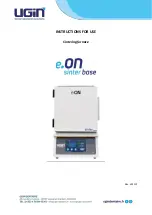
508183-01
Issue 2114
Page 19 of 52
Venting Practices
* See table 2 for allowable pipe.
NOTE
- Isolate piping at the point where it exits the outside wall or
roof in order to prevent transmission of vibration to the structure.
SCHEDULE 40
PVC - 5'
all other pipe* - 3'
Wall
e
d
i
s
t
u
o
e
d
i
s
n
i
24” maximum
3/4” minimum
Wall Thickness Guidelines
NOTE -
ward unit a minimum of 1/4” (6mm) drop for each 12” (305mm).
Figure 13. Piping Suspension Guidelines
•
In areas where piping penetrates joists or interior walls,
hole must be large enough to allow clearance on all
sides of pipe through center of hole using a hanger.
•
When furnace is installed in a residence where unit
is shut down for an extended period of time, such
as a vacation home, make provisions for draining
condensate collection trap and lines.
Removal of the Furnace from Common Vent
CARBON MONOXIDE POISONING HAZARD
Failure to follow the steps outlined below for each
appliance connected to the venting system being
placed into operation could result in carbon monoxide
poisoning or death.
The following steps shall be followed for each appliance
connected to the venting system being placed into
operation, while all other appliances connected to the
venting system are not in operation:
WARNING
In the event that an existing furnace is removed from
a venting system commonly run with separate gas
appliances, the venting system is likely to be too large to
properly vent the remaining attached appliances.
CHIMNEY
OR GAS
VENT
(Check sizing
for water
heater only)
FURNACE
WATER
HEATER
OPENINGS
(To Adjacent
Room)
If the
GUH96T
furnace replaces a furnace that was
commonly vented with another gas appliance, the size of
the existing vent pipe for that gas appliance must be
checked. Without the heat of the original furnace flue prod-
ucts, the existing vent pipe is probably oversized for the
single water heater or other appliance. The vent should be
checked for proper draw with the remaining appliance.
REPLACING FURNACE THAT
WAS PART OF A COMMON
VENT SYSTEM
Figure 14.
Conduct the following test while each appliance is operating
and the other appliances (which are not operating) remain
connected to the common venting system. If the venting
system has been installed improperly, you must correct
the system as indicated in the General Guidelines for Vent
1.
Seal any unused openings in the common venting
system.
2.
Inspect the venting system for proper size and
horizontal pitch. Determine that there is no blockage,
restriction, leakage, corrosion, or other deficiencies
which could cause an unsafe condition.
are wet with cement, forcefully insert end of pipe into
socket until it bottoms out. Turn PVC pipe 1/4 turn
during assembly (but not after pipe is fully inserted) to
distribute cement evenly. DO NOT turn ABS or cellular
core pipe.
NOTE:
Assembly should be completed within 20
seconds after last application of cement. Hammer
blows should not be used when inserting pipe.
8.
After assembly, wipe excess cement from pipe at end
of fitting socket. A properly made joint will show a bead
around its entire perimeter. Any gaps may indicate an
improper assembly due to insufficient solvent.
9. Handle joints carefully until completely set.












































